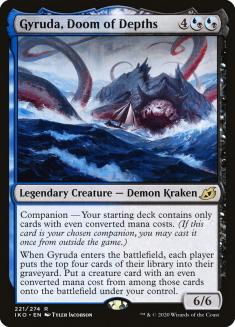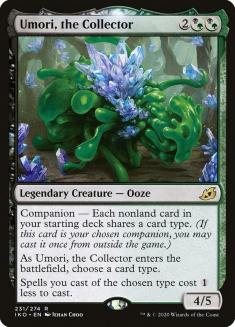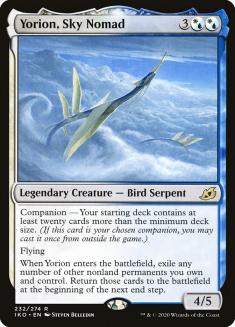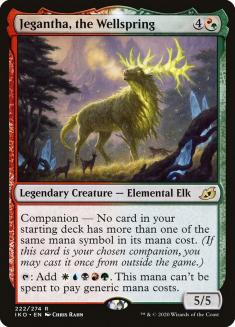We have a new companion rule, as you’ve likely seen:
This isn’t the change I anticipated because it doesn’t match the reminder text of companion at all, which is unfortunate, but I get that it can be considered acceptable because you can’t really figure out what companions do just by reading them without knowing the rule (I actually tried, and had no idea), so it should result in relatively minimal confusion. However, I do think it looks really unprofessional, particularly to more casual players who don’t know the tournament context that led to this change but just run across a companion in a few years, wonder what it is, read about it, and find out the card is lying to them. I think making a change that looks so unprofessional has costs in a game whose ultimate currency is player confidence. For that reason alone, I think this fix was the wrong direction. I think fully banning the mechanic would have been a less damaging look long-term, but here we are.
On power level, this nerf is in a similar ballpark to giving up a card: costs of cards show us that gaining a card in hand is generally worth two to three mana, so from a balance perspective, this is similar. For me, at that point, I’d have gone with the cleaner fix of giving up a card because it doesn’t involve the introduction of the arbitrary number “3” and it doesn’t strictly violate the reminder text. Mark Rosewater has written extensively about the importance of elegance, and this fix is maximally inelegant.
When someone makes a decision I wouldn’t have made, I try to give them the benefit of the doubt and examine why they made that decision — what things they valued differently to come to that conclusion. In this case, for example, I know with certainty that they must’ve considered the option to make players give up a card instead. The best way to figure out why someone did something is to start by listening to why they said they did it, if that’s an option, of course. Here, they did offer some reasoning.
I really like this reasoning, to be honest. If the rule had been that you have to put a card in your hand back to get access to your companion, that would have essentially no impact on a Legacy Lion’s Eye Diamond + Gyruda, Doom of Depths combo deck, for example. If companions just required giving up a card, then the sole advantage they convey is the consistency of always having the card, which means they’d only be used when that consistency is the point, which means they’d only be use to generate a repetitive play pattern. That fix would highlight the worst aspect of the mechanic.
They are correct that companions are now never part of a player’s best draws because spending three mana to put a card in your hand early won’t be the best play a winning deck can come up with. So now companions only matter late in the game, which means the game has already had time to be about other things.
From a power level standpoint, this impacts different companions very differently. Umori, the Collector, for example, is impacted particularly negatively as this all but invalidates the cost reduction ability. Umori’s purpose in most cases was to be cast as early as possible to save as much mana as possible, and now it basically doesn’t offer anything beyond the body.
Yorion, Sky Nomad, on the other hand, was always intended as a clean-up crew that only came down after you’ve cast most of your other cards, and it still does that, but obviously at a somewhat lower power level.
So where does this leave us? What does the future look like for companions?
They’re still a free resource, so if you don’t have to give anything up, they’re absolutely worth it. For this reason, takes I’ve already read like “They shadow-banned companions” or “Modern Burn won’t play Lurrus of the Dream-Den” are inaccurate.
Lurrus isn’t as strong in Burn as it was, not by a long shot — the tax definitely matters, but at the same time, the reason it was played initially was because you didn’t have to give anything up to do it. It’s still 100% right to give up a sideboard slot for a companion if you don’t have to change your deck for it, but it’s a lot more reasonable to not bother adding Mishra’s Bauble to your deck to work with Lurrus now, since Lurrus will come up in a lot fewer of your games.
Companions are still a free resource that some decks will have. Does this mean everyone should still try to have one? Obviously, there have been some successful Standard and Historic decks that haven’t had a companion already, and now the advantage they offer is more like half a card than a whole card — not necessarily half, but a fraction, in that none of the companions would be playable at three extra mana, so you now get a free card, but that free card is worse than any card you might have put in your deck (with some small possible exceptions). Yes, I think other decks can compete with that.
So where does that leave us?
Decks without companions are a lot more competitive because they’re at less of a disadvantage. However, you still need to weigh the costs of modifying any deck to include a companion against the benefit the companion offers. The benefit is mostly small now, so we’re mostly looking for times when the cost is low to identify when to play companions.
This is worst for curve-out, build-around companions like Umori, the Collector; Obosh, the Preypiercer; and Kaheera, the Orphanguard (when played as a lord, rather than as a free bad card in creatureless decks).
Gyruda and Yorion are the least impacted, since they cost the most mana and have the most impact when cast late. They’re still strong control finishers. Gyruda was hurt much more than Yorion because Gyruda was primarily played as a combo card, mostly because it’s a worse control finisher than Yorion.
I believe existing Yorion decks will be weaker because of this, but not so much weaker that they won’t be competitive or that they should generally become 60 cards and stop playing Yorion. I’m more confident about this in Modern than Standard or Pioneer, and it applies more to control decks than to linear decks that played extra cards for Yorion because the payoff was too strong to ignore.
I think about it like this —Yorion in your sideboard is a much bigger payoff than Battle of Wits in your library, and 80 cards isn’t in the same ballpark as 200+. In large formats, but maybe even in Standard, the cost of playing 80 cards has, I think pretty strongly at this point, been shown to have been very low. I think Yorion will likely be banned from one or more formats within the next year, because this change just doesn’t impact its power level enough, particularly relative to the other companions. I don’t think Yorion will be a huge problem before it’s banned; I think it’ll just show that it’s never going away and people will get sick of it. Then again, in Modern we’ve been stuck with a lot of things people are sick of, and in Standard, they can just wait for rotation, so they might decide to just leave it.
Lurrus of the Dream-Den might be banned with it or separately if it shows up too much because the opportunity cost is too low, but I think that’s less likely.
One thing I don’t like about how this all went down is that I don’t think this really opens up any new decks. I mentioned in my last article that introducing companions at a low power level would have been good because players would keep looking for ways to break them if they hadn’t found a way to win yet, but because they came in so strong, everyone has already thoroughly explored them. We know the best companion decks. We can try playing them and see if they’re still good enough with the extra tax. If they are, we keep playing them. If they aren’t, we move on to some other deck. I guess that’s one of many problems with using players to beta test unbalanced cards for you.
I suppose this does potentially open the door for Jegantha, the Wellspring. Jegantha’s weaker than the companions that saw play, but it has a relatively minor restriction. The biggest cost of playing Jegantha wasn’t the companion text but the fact that you couldn’t have another companion. Now, not having that other companion doesn’t matter as much because the other companion isn’t as strong, which means that it might not be worth going out of the way to have it, so you give up on the other companion, and now that it’s out of the way, Jegantha is looking a lot more appealing. Jegantha’s like the casual hookup companion — it’s around when you’re not ready for the commitment of a demanding companion, even if it doesn’t offer quite as much.
Consider a red aggressive deck in Ikoria Standard. Obosh makes your curve weird, which isn’t great for an aggro deck, but it offers an immediate impact for five mana, which is a great payoff. At three extra mana, that payoff is much less appealing, so I’m not so inclined to give up my two-drops (or those high-impact four-drops that used to define red). So I break up with Obosh to hang out with Runaway Steam-Kin and Experimental Frenzy again. Well, now I’m free to pick up Jegantha as long as I’m not too attached to Anax, Hardened in the Forge or Torbran, Thane of Red Fell.
All in all, my real conclusion is that this hurts high-deckbuilding-cost, high-power-level companions the most, and that creates space for low-deckbuilding-cost, low-payoff companions that weren’t worth giving up a good companion before. This means more Jegantha in random decks and more Kaheera in creatureless decks, and a lot less Obosh. Lurrus and Yorion were both high-payoff and low-cost in most cases (which is to say they were just poorly balanced) and should continue to see substantial use. They’ll be somewhat less oppressive when played, and time will tell whether that leads to future bans, but I think only those two are dangerous now, rather than thinking that, if they were banned, we’d just see the next tier of companions take their place.







